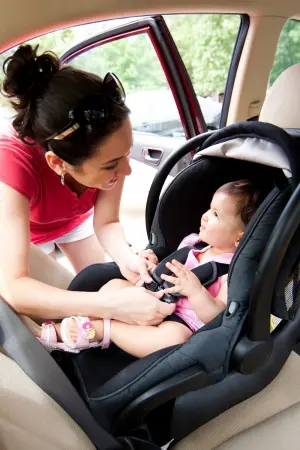Common Car Seat Mistakes
 New laws & common car seat mistakes
New laws & common car seat mistakes
Pennsylvania’s new car seat law goes into effect next month. The new law will require all children to be restrained in a rear-facing car seat until at least two years of age.
Why is rear-facing safer?
A rear-facing car seat supports the head and neck, and is designed to distribute the force of a crash across the shell of the car seat in the event of a car accident. Babies’ necks and spinal cords aren’t yet strong enough to withstand the force of a crash or sudden stop. Children under two are five times less likely to die or suffer serious injury in a car accident when restrained in a rear-facing seat.
Switching to a front-facing seat too soon is one of the most common car seat mistakes parents make. Here are some others:
Common Car Seat Mistakes
1. Loose straps. If the harness straps are too loose, your child may be ejected from the seat in a crash. Straps should lay flat on your child’s chest, with no twists or extra slack.
2. Chest clip is too low. The chest clip should sit at armpit-level. If the chest clip is too low, it won’t do its job of helping to restrain your child in case of a car accident. It can even cause damage to internal organs in the abdominal region.
3. Improper installation. Three out of four car seats are not installed correctly. Be sure to follow the manufacturer instructions exactly. Note that not all car seats are designed the same way.
- If the seat belt or lower anchor is too loose, the car seat will not stay put. Make sure the seat does not move more than one inch in any direction once installed.
- Secure the top tether.
- Not all car seats are meant to be used in the rear center seat. Check your car seat’s instructions to be sure.
- Use either a seat belt OR the LATCH (Lower anchor and tethers for children) to secure your child’s car seat, but not both at the same time.
4. Moving from a car seat or booster seat too soon. Under Pennsylvania law, children under 4 ride in a car seat, and children ages 4-8 use a booster seat. Seat belts are designed for adults, not children, and transitioning out of a child seat prematurely can result in worse injuries in the event of a crash. How do you know when it’s time to get rid of the booster seat? Children should sit with their knees bending at the edge of the seat, and with feet on the floor. The lap belt should sit across the hips (not the abdomen) and the shoulder belt should go across the chest/collarbone (not the neck). Additionally, children under 13 should not ride in the front seat.
Free Consultations Available
Using car seats and seat belts correctly is the #1 way to prevent serious injury or death in a car accident. For more information, visit [email protected], or locate a certified child passenger safety technician in your area. If you suffer an injury in a car accident, contact a car accident lawyer at Munley Law Personal Injury Attorneys for a free consultation.
Posted in Personal Injury.









